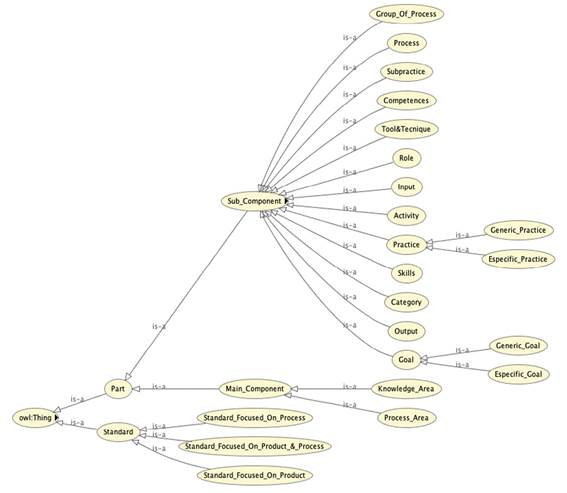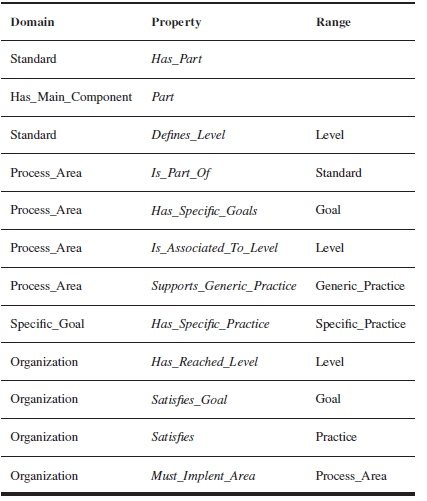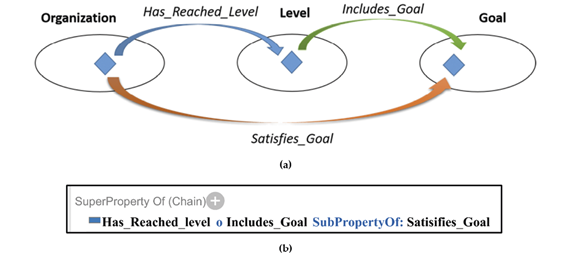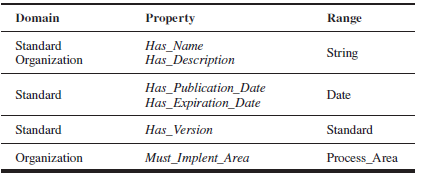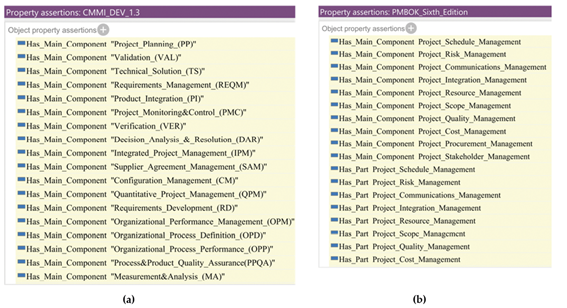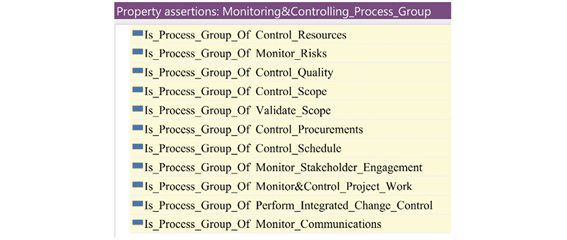I. Introduction
NOWADAYS, the number and complexity of software projects are growing more and more. However, it is noteworthy the number of projects that ar e not successful in terms of time, cost, and software quality. For example, according to the Chaos report in 2020, only 35% of projects were fully successful in terms of time and budget 1]. The adoption of good practices to carry out the software development process is a suitable alternative to increase the success probability. The good practices include the application of guidelines to carry out each stage of the software lifecycle as well as the application of international standards. These standards are internationally agreed by experts and are promoted by important organizations in the software industry. For example, the International Organization for Standardization (ISO), together with the International Electrotechnical Commission (IEC), provide some of the most important international standards. Likewise, the Software Engineering Institute (SEI) 2 and the Institute of Electrical and Electrotonic Engineering (IEEE) are two relevant organizations in the definition of international standards. A standard is a document established by an authority, custom, or general consent as a model or an example 3].
In spite of the positive impact of adopting standards, it is not a straightforward task. The standards are usually described in complex and large documents represented by natural language. Hence, the analysis of these documents is a complex task, especially if several standards are being analyzed. For example, it is possible to find different terms for the same concept or the same term for different concepts for different standards. These issues hinder the right application of the standards; for instance, it is not easy to choose the proper standard for a project according to its characteristics.
On the other hand, applying formal models to partially describe the knowledge of the standards might be an alternative to tackle the aforementioned issues. In that sense, the ontologies, represented by means of Ontology Web Language (OWL), are an artificial intelligence technique that has been used to represent and analyze knowledge in different domains 4-6]. The ontologies allow to represent the knowledge of a domain and support the reasoning tasks on the concepts 7]. They also contribute to a shared understanding among different agents, such as people and software systems 8].
The main problem addressed by this research is related to how to increase the quality of descriptions about quality standards and consequently increase their accuracy and understandability as well as to reduce the time needed to get relevant information. To deal with this problem and considering the advantages of ontologies, this paper aims to describe an ontology-based approach to representing and analyzing the knowledge related to software development standards. The ontology was elaborated following a sound methodology that includes seven stages. The execution of these stages allowed us to define the classes, properties, and individuals of our ontology. In this process we analyzed a set of international standards to create a general ontology that could be used to represent information from different sources. Since several standards will be represented by means of the same ontology, a reasoner could analyze it to automatically validate the information and infer new knowledge. To demonstrate the applicability of the ontology, we populated it with knowledge of two standards. This ontology is a feasible tool to support the unification, integration, and reduction of conceptual ambiguity of software standards descriptions. Therefore, it might contribute to improving the accuracy of these descriptions and consequently make it easier the understanding of software standards.
Besides, once this ontology is populated it may be considered a knowledge base. Hence, it could be queried to carry out intelligent searches according to the user's needs. For example, a user could query this knowledge base to know the most suitable standard taking into account the characteristics of his project. Furthermore, since the knowledge will be explicitly described, the adoption of this type of approach could contribute to avoid misunderstanding and enhance the commutation of all stakeholders. On the other hand, with the systematic application of this ontology it will be possible to gather information regarding the results of applying a specific standard in a project. Therefore, the users could analyze all this information and use it to make decisions.
The structure of the paper is as follows: section 2 briefly analyzes some elements about standards and ontologies. In section 3 the main components of our ontology are described and a case study to demonstrate the applicability of our approach is presented. Finally, conclusions and future work are introduced.
II. Materials and Methods
To perform this research, several research methods were used. First of all, a survey was conducted to identify the most common quality standards in the domain of software development. Based on the results of this survey, we carried out a documentary analysis to know the main components of the most adopted standards. These results were used as an insight to create the ontology that is presented in this article. To validate the ontology, a case study was implemented. For this case study, we used ontology to represent the knowledge of several quality standards. This case study demonstrated the applicability of the proposal to represent knowledge and to make easier the analysis of quality standards.
In addition to these research methods, we describe in this section the particular methodology, language and tool that were adopted to create the ontology. These elements are key to ensure the quality of the ontology from early stages of the development process.
A. Survey to identify Standards for the software development process
A survey was conducted to identify the most representative standards. In this study, software developers of two software development companies participated. We asked the participants to mention the best standards for the software development process. ISO and Capacity Maturity Model Integrated (CMMI) got the best results. Based on these results, we carried out an analysis of these two standards to know their main components. These results were used to create the ontology that will be described above in this paper.
Software quality standards include specifications to ensure that the outputs of the software development process meet business expectations. This guides the appropriate application of software engineering 9]. Hence, it plays a crucial role in managing and ensuring software quality. The standards focus either on the process or the product 10].
ISO 9001:2015 has been widely implemented for quality management around the world. It includes a set of principles to the right implementation of a system of quality management in organizations that develop software or provide services 11]. CMMI is based on Capacity Maturity Model (CMM). The aim of CMMI is to assess and enhance the maturity of the processes of software development. The Guide to the Project Management Body of Knowledge (PMBOK) provides guidelines for managing projects. PMBOK describes the projects lifecycle and their processes 3].
B. Documentary analysis
As Andrade et al defined, a Documentary analysis is a procedure which encompasses the identification, verification and consideration of documents which are related to the object investigated 12]. In our research, we are interested in considering documents which describe standards for the software development process. Since we previously conducted a survey to identify the most used standards for software development, we focused the analysis on those selected standards. Specifically, we used the normative documents of the respective standards.
This analysis allowed us to understand better the knowledge related to these standards. By means of this technique, the general structure of each standard was identified, as well as their main components. These results were an important insight to develop the ontology that is presented in this paper. Likewise, we used the results of this study to populate the ontology and evaluate its quality.
C. Case Study
To carry out the case study we followed the steps defined by Crowe et al 13]:Defining the case; Selecting the cases; Collecting the data; andAnalyzing, interpreting and reporting case studies. In our research, we defined our cases as the descriptions of software quality standards that were specified by means of the ontology developed in this research. Our focus was on how a formal description of standards can contribute to improving the accuracy of these descriptions and, consequently, make it easier the understanding of software standards. Based on the results of the survey mentioned above, we focused our study on the standards CMMI, ISO and PMBOK.
Regarding the data collection, first of all, we used the official descriptions of these standards 2, 3, 11]. This collected information was used in the process of creating the ontology as well as to populate it. Finally, the step of analyzing the results was guided by a set of competence questions. We evaluated how the ontology was able to answer these questions.Section 3. Cdescribes the main results of this case study.
D. Methodology and tools adopted to develop the Ontology
As was mentioned in the introduction, this paper aims to describe an ontology-based approach to representing and analyzing the knowledge related to software development standards. An ontology is a formal and explicit specification of a shared conceptualization 14]. It is composed of concepts, axioms, or inference rules that can be used to infer new knowledge. The ontologies contribute to detecting and removing ambiguities 15]. They are a tool to manage the knowledge of a specific domain, enhancing the understanding of the specifications and creating new knowledge.
A crucial step to ensure the quality of an ontology is the selection of the methodology that will guide the ontology development process. Likewise, it is relevant to select the right language and the tool to implement the ontology.
The development of our ontology was guided by the methodology proposed by Noy and McGuinness, which has been extensively adopted 16]. This methodology is one of the most used or cited for designing an ontology 17]. It includes the following steps: Determine the domain and scope of the ontology, consider reusing existing ontologies, list the relevant terms of the ontology, define the classes and the class hierarchy, define the properties (called relationships or slots) of the classes, define facets and/or restrictions on slots or relationships and finally define instances.
Web Ontology Language (OWL) is one of the most prominent languages to represent ontologies. OWL allows to describe concepts and relationships among them 18]. To create and edit the ontology we employed the tool Protégé because it is an open-source platform that has been used extensively to manage ontologies in OWL 19].
III. Results and Discussion
A. Ontology to represent the knowledge of software quality standards
Following the steps of the methodology described in the previous section, an ontology to represent and analyze the knowledge of software standards was developed. Below the main results of the otology development process are analyzed.
Step 1. Define the domain and scope of the ontology.
The main goal of the ontology is to support the analysis of software standards. Its application will contribute to enhancing the understanding of a specific software standard as well as finding common concepts and terms among different standards. To assess the compliance of these objectives, the following competence questions (CQs) were defined:
CQ 1.What are the main components and subcomponents of a specific standard?
CQ 2.What goals and practices are satisfied for a company that reached a certain maturity level?
CQ 3.What process areas should be implemented in an organization to reach the next maturity level?
CQ 4.What companies have a level that is not according to the practices or goals that they accomplish?
CQ 5.What specifications are common in different standards?
CQ 1 is focused on the concepts that compose each standard. It has been used to represent information about CMMI_DEV version 1.3 and PMBOK 6thedition to illustrate the applicability of our approach. Hence, CQ 1 will be answered with specific information about these standards. CQ 2, CQ 3 and CQ 4 focus on the information that can be inferred in an organization that implements a standard, in this case, CMMI_DEV. CQ 5 will allow to know the concepts in a standard which have a correspondent concept in other standards.
Step 2. Consider reusing existing ontologies
Since we did not find ontologies in the English language, we do not reuse ontological resources from other ontologies.
Step 3: List the relevant terms of the ontology.
To identify relevant terms, we conducted a documentary analysis of several references that describe standards. Some relevant terms are Process, Area, Practice, Goal, Tool, Level, Input, Output, among others.
Step 4: Define the classes and the class hierarchy
In this stage, we analyzed the identified terms in the previous stage to decide which of them will be considered as classes in ontology. After this analysis, 48 classes were identified. The classesStandardandPartare two of the most significant classes in the ontological model. Each of these classes subsumes other classes to characterize the individuals that compose it and thus provide analysis of interest.Fig. 1depicts the hierarchy of the classesPartandStandard. We defined that aStandardis composed of a set ofMain_Components, and eachMain_Componentis composed of a set ofSub_Components. The types ofMain_ComponentandSubcomponentdepend on the Standard. For example,Knowledge_Area andProcess_Areaare the main components of the standards PMBOK_Edition_7th and CMMI_Dev_1.3, respectively. Whereas aKnowledge_Areaincludes a set ofProcesses, aProcess_Areais composed ofGoalsandPractices. On the other hand, we included classes to classify a Standard according to its purpose. Thus, we have the classesStandard_Focused_On_Process,Standard_Focused_On_Productand Standard_Focused_On_Product&Process.
Step 5: Define the properties
The properties are the other key component in an ontology. OWL defines two types of properties,objectanddata properties. An object property allows representing a relationship between two individuals. In OWL, to define the classes that can use a property, the domain and range of the property should be defined. For example, an individual of the classStandard Has_Main_Partindividuals of the classPart. For this example, the propertyHas_Main_Parthas the classesStandardandPartas domain and range, respectively.Table 1shows some of the object properties for the classesStandard,Process_Area,Goal, andOrganization. In total, the ontology includes 67 object properties. Furthermore, the expressive richness of OWL allows us to specify an inverse for each property. For example, the propertySupports_Generic_Practicehas the inverse propertyIs_Supported_By. IfA Supports_Generic_Practice P, then a reasoner will infer thatP Is_Supported_By A.
In OWL, it is possible to specify the characteristics of an object property. For example, to answer CQ 5 we created the object propertyIs_Compatible_Withto relate the elements of different standards that are similar. This property was defined as symmetric, which means that if f AIs_Compatible_WithB then the reasoner infers that BIs_Compatible_WithA.
The expressive richness of OWL allows to represent not only direct relationships between individuals; it is possible represent more complex relationships by means of property chains. For example, if a company has adopted theStandardCMMI_DEV and has reached the maturity level 4 (Quantitatively managed), we would like to know the goals and practices that this company satisfies.Fig. 2a) shows a representation of the relationship among the classesOrganization, Level, andGoal. WhereasFig. 2b) shows how this relationship was expressed by means of a property chain (Satisfies_Goal). A similar property chain was defined to represent the relationship betweenOrganizationandPracticeby means of the object propertySatisfies_Practice.
On the other hand, data properties allow to define some basic attributes for the classes. For example,Table 2shows some of the data properties identified for the classesStandardandOrganization. Similarly, to object properties, data properties have domain and range, but in this case, the range is a data type, for example, String, Integer, Date, etc.
Step 6: Define facets and/or restrictions
OWL allows specifying universal and existential restrictions. For example,Fig. 3shows the existential restriction to express that aStandard Has_Main_Componentsome instances of the classMain_Component. It means that each Standard should have at least oneMain_Component. WhereasFig. 3also depicts a universal restriction (identified for the wordonly). With this statement, if a Standard S is related to an individual X by means of the propertyHas_Main_Component, the reasoner will classifyXas aMain_Component.
On the other hand, OWL allows defining sets of necessary and sufficient conditions for a specific class. The classes with this type of conditions are named defined classes. The main advantage of this type of classes is that a reasoner can automatically infer the individuals that belong to them. To take advantage of these potentialities, several defined classes were created. For example, we created the classOrganization_Level_4for the organizations that adopted theStandardCMMI_DEV and have reached the maturity level 4 (Quantitatively managed).Fig. 4shows this specification.
We used Semantic Web Rule Language (SWRL) to specify more complex relations. For example, to answer CQ 5 we created the ClassCompany_With_Problemsand specified Rule 1 to infer the companies that belong to this class.
Step 7. Define instances
In this step, instances of each class are defined, and the necessary axioms to link them are established. A case study with results of this step is explained in the next section. Furthermore, this case study demonstrates the applicability and usefulness of this ontology.
B. Ontology validation
To validate the ontology, we checked thata) it meets the specifications of a formal-logical system; andb) it satisfies the requirements for which it was created. A reasoner is used to verify that the specifications as a formal-logical system are fulfilled. In this case, we used the reasoner Pellet 20], which confirmed that the ontology is consistent. The ontology evaluation is an iterative and progressive process. Throughout the life cycle of ontology development, we continually use the reasoner to verify the consistency of the ontology.
In addition, the last version of the ontology was tested by using OntOlogy Pitfall Scanner (OOPS!) 21]. After four iterations, all the problems detected by OOPS were fixed. This evaluation helped to detect and correct some pitfalls in our ontology.
We carried out a case study to demonstrate that the ontology satisfies the requirements for which it was created. In this case study, we verified that all competency questions were answered correctly by the ontology. The case study described in the next section also illustrates the usefulness and applicability of our ontology.
C. Case Study
A case study is presented below to demonstrate the applicability and usefulness of the ontology. As mentioned before, we presented in our ontology the information about the standard CMMI_Dev version 3.1 and the guide PMBOK 6thedition. In spite of the fact that PMBOK is not a standard, it has been extensively adopted to guide the development of different types of projects 22]. We created the individuals PMBOK_6th_Edition and CMMI_Dev_3.1 as instances of the classStandard. Then the respective axioms to represent the particular information of each standard were created. For example, the main components ofPMBOK_6 th _Editionare instances of the classKnowledge_Area, whiles forCMMI_Dev_3.1are instances of the classProcess_Area. To answer CQ 1,Fig. 5shows the main components of the StandardsCMMI_Dev_3.1andPMBOK_6th_Edition. Considering these statements, the reasoner will classify the instances of these two classes asMain_Component.
In addition to know the main components of a standard, it is useful to know about the other subcomponents. For example, inPMBOK_6 th _Edition, each process belongs to a group of processes. Hence, it is interesting to know the list of processes that belong to a specific group of processes.Fig. 6shows the processes that belong to theGroup_of_Processes Monitoring&Controlling_Process_Group.
Since we defined a set of property chains, it is possible to get information about individuals who do not have direct relationships as well. For example, it is possible to know the inputs or outputs of a specificGroup_Of_Processor aKnowledge_Area.Fig. 7a) shows the inputs/outputs of theKnowledge_AreaPoject_Quality_Management, andFig. 7b) shows the inputs/outputs of theGroup_Of_Process Executing_Process_Group. Likewise, taking into account the specifications of the ontology, it is possible to know the list of processes where certain work document is used. These examples illustrate the usefulness of the expressive richness of OWL. The application of this ontology could speed up the analysis of the standards.

Fig. 7. List of inputs/outputs of (a) the Knowledge_Area Poject_Quality_Management; and (b) the Group_Of_Process Executing_Process_Group.
To exemplify how the ontology is able to answer CQ 2 and CQ 3, we added the individualsCompany_Soft&Serv_For_HealthandSoftware_Company_Multi_Systemas instances of the classOrganization. For Software_Company_Multi_System, we added the axiom to define that this company reached maturity level 5 (ML5_Optimizingin the ontology).Fig. 8a) shows that the reasoner inferred the goals and practices that this company satisfies. ForCompany_Soft&Serv_For_Health, we added the axiom to define that reached the level 4 (ML4_Quantitatively_Managedin the ontology).Fig. 8b) shows that the reasoner inferred that this company must implement the process areasOrganizational_Performance_Management_(OPM)andCausal_Analysis_&_Resolution_(CAR)to reach the next level. The answers to CQ 2 and CQ 3 may be a useful insight to decisions according to a company's level.
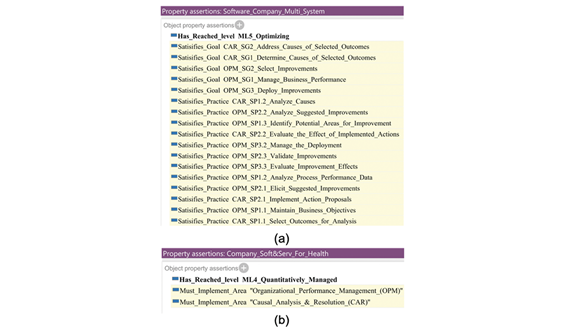
Fig. 8. (a) Inference of the goals and practices that a company satisfies; (b) Inference of the process areas that a company should implement.
To answer CQ 4, we specified that the companySoftware_Company_Multi_Systemdoes not satisfy the goalOPM_SG1_Manage_Business_Performance, which is a goal that must satisfy the companies that reached level 5. Since we previously defined that this company reached level 5, the reasoner classified this company asCompany_With_Problems, asFig. 9shows. This type of inference is useful to detect inconsistencies due to either human mistakes adding to the information or real problems with the companies that are not implementing goals or practices that they should implement. Specifically, this type of analysis is common after a company has been assessed.
To illustrate how CQ 5 is answered, we created in the ontology the classComponent_Multi_Standard. Furthermore, we defined the necessary and sufficient conditions to automatically classify the instances of this class (Fig. 10 a).Fig. 10 b) shows that the reasoner identified a group of individuals that belong to the classComponent_Multi_Standard. For example, asFig. 10d) shows,Project_Quality_Management is Compatible_WithProcess&Product_Quality_Assurance(PPQA). Since the propertyCompatible_Withwas defined as symmetric, the reasoner inferred thatProcess&Product_Quality_Assurance(PPQA)isCompatible_With Project_Quality_ManagementasFig. 10c) shows.
IV. Concussions and Future Work
This work presented an ontological approach to representing and analyzing the knowledge of different standards. We described how the expressive richness of OWL was exploited to represent a wide diversity of relationships. The ontology includes specifications to represent not only the specific information of a standard, but it is possible to relate this information with the data of the organizations and identify common concepts among different standards. We demonstrated by means of a case study that this approach could support the analysis of different standards. This ontological model could be a useful tool to speed up the adoption of a standard. Furthermore, the ontology might be used as a valuable material to train company personal staff. On the other hand, since OWL is a formal language, this ontology allows detecting inconsistencies or ambiguities. The systematic application of this approach will help to populate the ontology. Hence this ontology could represent a reference knowledge base.
Our future work will be focused on the extension of the ontology to represent the information of other standards and identify the common concepts among different standards. Furthermore, we are designing an experiment to assess the impact of this approach to improve the analysis of these standards in terms of time and quality of the analysis. In addition, we are examining approaches to automatically extract information from documents in natural language. With the application of this type of approach, the population of the ontology could be easier. Finally, since we expect to populate this ontology with the information of a significant number of standards and companies, we are exploring alternatives to address its scalability.














